There is no question about it – labradors love food and are greedy! The most important thing is to provide a balanced diet.
Labradors are not finished growing until 18-24 months old. During this time, their bone structure and joints are still developing and ossifying (forming and hardening), and the right amount of calcium and nutrients in their diet is critical.
We hope you will find our diet information interesting and inspiring. We strongly believe that health comes from within.
Many dog owners remain naive about nutrition and appropriate diet for their dog. This is largely because of the commercialisation and advertisement tactics surrounding dog food, and the huge effort by dog food companies and brands to make their food seem the best and only way. We want our puppy owners, and all dog owners, to be as well-educated and able to make informed choices as we are.
While there are a range of approaches to canine diet and feeding out there, the preference/approach we choose for our dogs, is based on our own research and experience, with our dogs’ best interests at heart. We believe natural is best and that health comes from within. Our dogs sport shiny coats and healthy physiques as a result.
Balance
Nature is always working to restore and maintain a state of health. Health means a state of balance, called homeostasis. Health is a condition where all the tissues, organs, and systems of the body are functioning in a normal manner. To maintain health, the body needs the right amounts of vitamins, minerals, trace elements and nutrients to sustain normal function and be healthy.
Of course you’ve heard it said that your dog requires a balanced diet. But what is balanced?
If you ate the one food all the time, your nutritional levels inside your body would become very unbalanced, since one food alone cannot provide all the nutrients that are necessary to maintain healthy body funcitons. A variety of foods need to be metabolised in order to provide the essential nutrients, vitamins, minerals, trace elements, and electrolytes that your dog’s body needs to maintain normal physiological functions.
Cells require many different nutrients contained in the forms of water, carbohydrates, proteins, fats, minerals and vitamins. These nutrients have responsibilities in every aspect of normal homeostatic processes in the body, including regulating cell fluid levels, supplying glucose and energy, tissue building, and, regulating cell functions, growth and repair.
This is why your dog needs a variety of foods to provide the necessary nutrition to maintain healthy.
What we feed
We acknowledge there are a range of approaches to canine diet and feeding out there. Our preference / approach we choose for our dogs, is based on research we have done and on more than a decade of experience feeding our dogs and providing them with nutritious meals. Our preference is to feed a combination of raw food (meat and veg) alongside kibble (dry food).
To clarify, raw means feeding a combination of raw meats, organ and bone, plus vegetables; and kibble means a premium quality dry food.
The issue with today’s dry dog food brands, of which there are many, is that most contain cheap and extremely unhealthy fillers to make the food stick together, to bulk it up, and to make it cheaper to produce. This is responsible for contributing to overweight dogs, health problems, and cancers.
Hence, in terms of dry food, we recommend premium quality for Kodalihart puppies. Premium quality brands include Ivory Coat, Ziwi Peak, Taste of the Wild, Applause, and Canidae Pure.
Although we are not against dogs having grain entirely, we know that they do not require grains in their diets, and that the carbohydrate converts to sugar, contributing to weight-gain (labradors are already naturally prone to weight-gain). A high-quality dry food should not consist of grain fillers, and its primary ingredients (the first few ingredients listed on the packing) should be meats.
We recommend our puppy owners feed their puppies a combination of kibble and raw throughout the dog’s lifetime. If raw-feeding is not possible, then an absolute premium quality dry food is a must. However, we hope to inspire you to include some raw feeding.
Watch this short video on the History of Dog Food
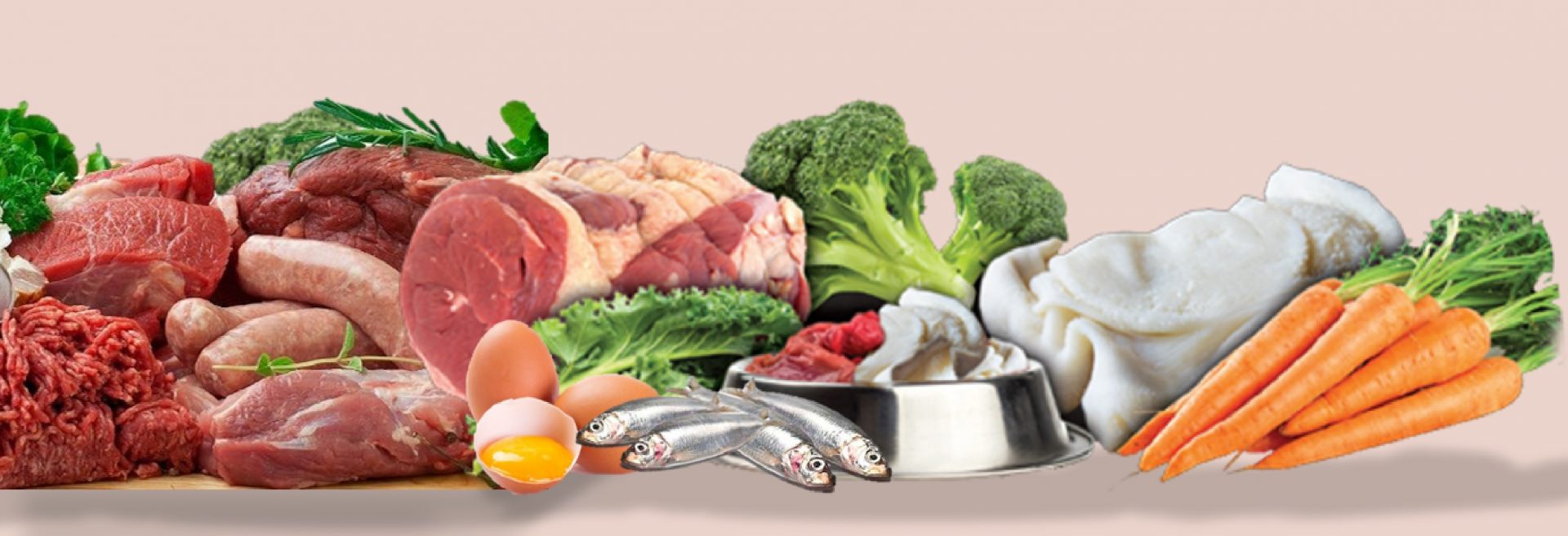
Raw Feeding
If you don’t already know what this is, we’re going to introduce you to what is known as BARF – Biologically Appropriate Raw Food.
Raw feeding in this way attempts to mimic the proportions of meat, organ, bone and vegetable that dogs in nature would have eaten. Based on the belief that for dogs to achieve the long and healthy life they deserve, they should eat what nature intended them to eat.
A BARF diet is based on fresh raw foods: raw animal protein (meat, organ/offal, and bones), raw vegetables and fruit, raw whole eggs, yoghurt, kelp, and healthy fresh herbs.
Our homemade BARF meals are based on what is known as 70/10/10/10 ratio, which attempts to mimic the amounts of meat, organ, bone and vegetable that might be consumed by a dog in nature.
We find this to be a fantastic raw feeding ratio. Not only do our dogs love it, but they sport shiny coats and healthy physiques to show for it.
Some people who are not aware about appropriate raw feeding, think that feeding their dog some raw mince such as beef, lamb, or chicken (which is muscle meat only), is ‘raw feeding’. Muscle tissue of meat and poultry alone cannot supply complete nutrition to the dog. They supply high quality protein and phosphorus, however are deficient in adequate calcium, sodium, copper, iodine and several trace elements that are essential. This is why it’s important to feed 70% as muscle meat, plus 10% bone (source of calcium for example), 10% organs (provides a lot of the essential minerals and vitamins that are missing in muscle meat alone), and 10% vegetables.
A correct raw diet includes meat and organ and bone, not just muscle meat.
Perfectly Rawsome is a really good resource if you are wanting to expand your knowledge on raw feeding, including ratios, raw feeding calculator, and recipes, and the theory behind BARF diet.
Dogs Naturally Magazine and online videos also discuss raw feeding.
Preparing raw meals
You only need the knowledge, ingredients, a bucket or tub for mixing, containers and a freezer. This diet is surprisingly EASY to prepare (we pre-prepare and freeze it in containers ready to thaw and use). Proper food-handling techniques (keeping meat cold, freezing and thawing appropriately) will prevent bacteria and contamination of meat, just like with human-grade food.
Making raw meals in bulk batches is easier and cheaper. Our process is simple: source the ingredients (fresher is better), cut or mince the meat/organ component, grate or mince the raw vegetables, mix together, measure into containers and freeze.
A variety of meat species is ideal. We choose several different species of meat – beef, deer, chicken, lamb, roo, turkey, rabbit, fish – to include in our labrador’s diet. Not all at once of course – we vary it slightly each time we make and freeze a new batch of raw food.
The types of meats and vegetables used can be alternated or rotated to keep it interesting for your dog and to promote balanced nutrition.
Our preparation process (remember we make bulk, as we are feeding many dogs, plus it saves time and cost):
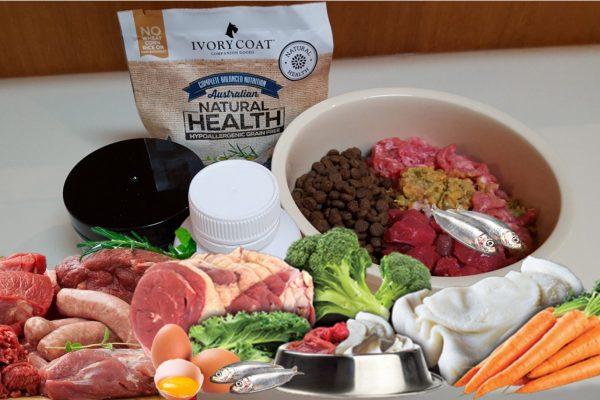
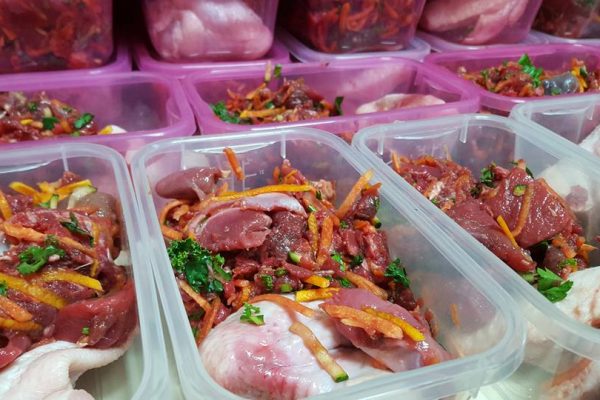
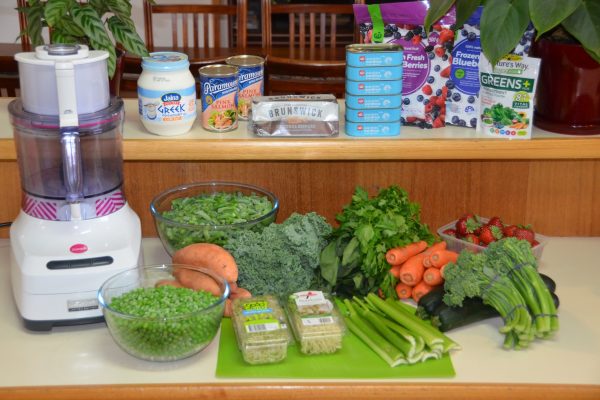
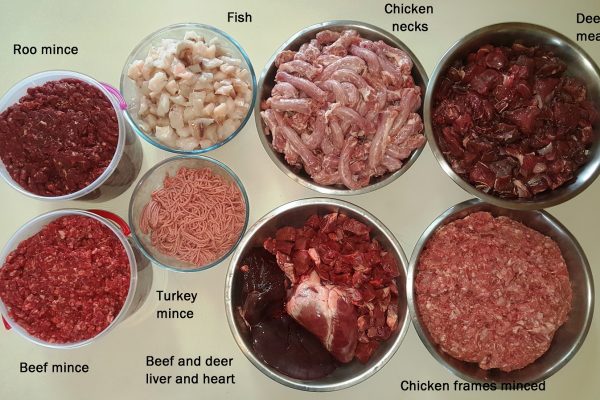
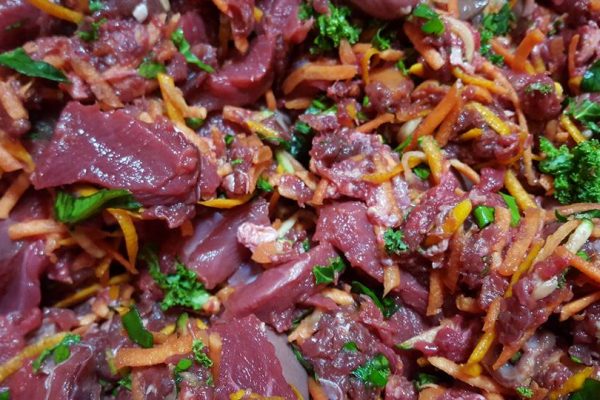
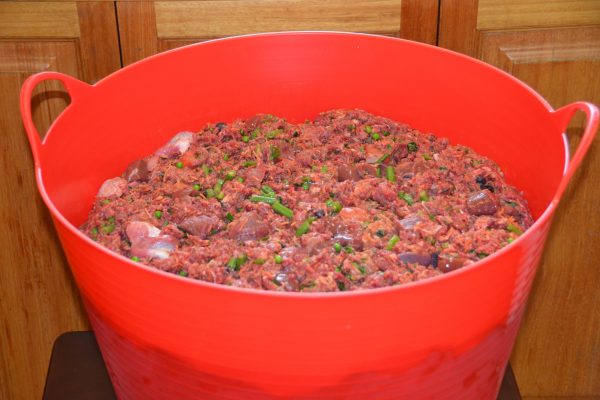
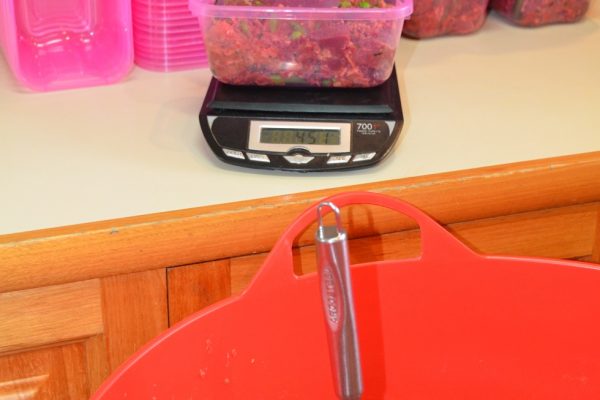
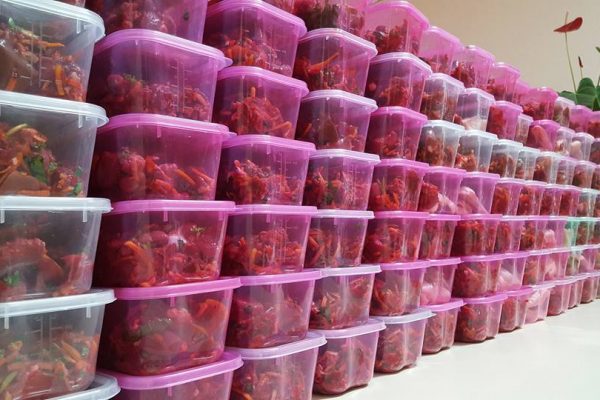
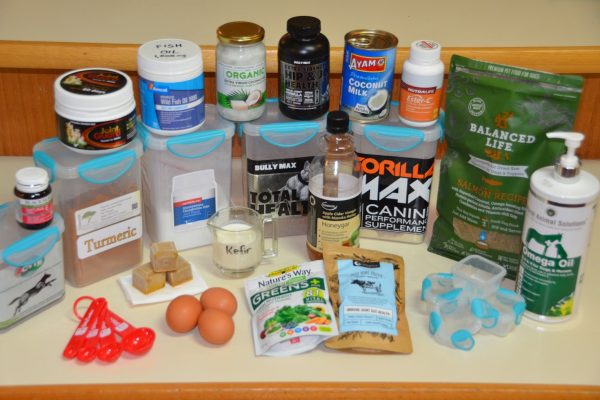
Cost and sourcing ingredients
Contrary to popular thought, making raw meals the way we do, is not expensive. In fact, it works out the same cost as buying a can of processed dog food from a supermarket shelf. One raw meal = same cost as a 400g can of dog food off the supermarket shelf. We have calculated this out several times on different batches of meals we prepared and our finding was consistent – making raw food (in bulk) does not cost more per meal than a can of processed dog food.
Making bulk raw meals and placing in the freezer does save money, preserve time, and is convenient.
Scout local shops and butchers and fresh food markets to source the best places to gather your ingredients from. For example, our local Lenards Chicken in the IGA supermarket minces up chicken frames in a ‘pet chicken mince’ which is obviously a great source of calcium. Our brothers hunt locally so we regularly get fresh game meat from them. One of our local fresh food markets supplies a range of organ meats that are good quality and yet cheap (chicken wings/necks/feet, lamb fry or liver, kidney and heart, turkey wings, and they also do a pet mince too).
Be aware:
- some pet shops supply their own fresh or frozen ‘pet mince’ – most often the meat comes from animals at the abattoir that did not make it to the human meat-market, usually due to illness, disease, and contamination. One would want to consider this carefully and find out where the meat is coming from.
- We choose to source meat, organ and offal from butchers, where we know the animals have made it here because they were considered safe for human consumption. This is why we get our ‘pet quality minces’ from our local fresh food market and butchers.
- ‘Pet mince’ alone cannot be considered a balanced meal – even if it contains some vegetables thrown in. It is still lacking in essential nutrients that are found in organ meat, so if you do choose to use a pet mince, be sure to add organ and vegetable component.
Vegetables for puppies
Vegetables for puppies should be cooked and mashed until 4-5 months old, then gradually transition onto raw vegetables, either grated or pureed. This is because puppies’ digestive systems have not fully developed yet and they process the vegetables better cooked. Once their digestive system has strengthened and developed sufficiently, transitioning to raw vegetables is healthy for them. Use a variety of orange and green vegetables (about half of each). Overdoing the orange vegetable can lead to too much Vitamin A in their diet.
It is also important to remember that dogs can have allergies, so if they cannot tolerate a certain meat variety, just leave that out.
Under the ‘Food and Nutrition Album’ on our Facebook Page are examples of meal preparations that you might find inspirational.
Whilst there are no outlets near us selling pre-made BARF meals, I believe you can buy BARF, Big Dog, and Prime 100 raw meals for dogs from certain pet food stores, nearer the city is easier, such as My Pet Warehouse.
How much raw food to feed?
Using the BARF and raw feeding recommendations, food amount by weight should be approximately 2-3% of the dog’s ideal body weight (per day).
So, since we feed one raw and one kibble meal each day, we need to divide the recommended daily amount in half.
For example, a 30kg labrador would eat about 300 – 450 grams for one meal of raw food. If aiming to loose a little weight, we would adjust the amount and feed less. If your dog needs to gain some body condition, you can increase the amount to 4% of the dog’s ideal body weight.
An example of how to calculate raw food amount by weight:
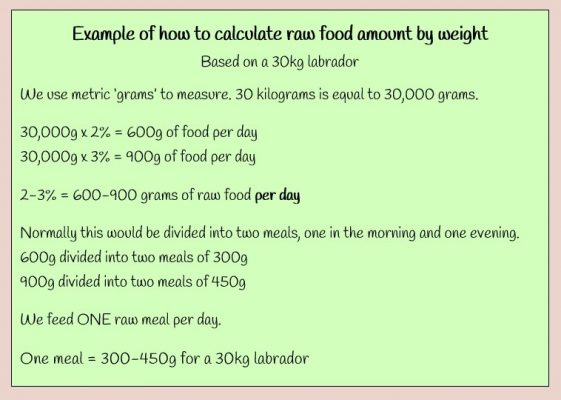
Is your dog fit or fat?
A fit labrador is a healthy labrador.
Being overweight is unhealthy and places harmful stress on joints, leads to heart disease, and increases risk of injury due to deconditioning. Always aim for a healthy body condition – not overweight but also not too thin. Labradors are water dogs and typically have some ‘condition‘ (body fat) on them to protect their internal organs (especially their kidneys) from the cold of the water.
We like to use the Varsity Pets Body Condition Scoring Chart as a guide to assess body condition. In other words, gauging the dog’s body weight, fat percentage and condition. A body condition score of 5 would be ideal for a healthy labrador, especially a labrador who swims alot.
Knowing your dog’s body condition is better than assessing just their weight alone, as each dog is individual.
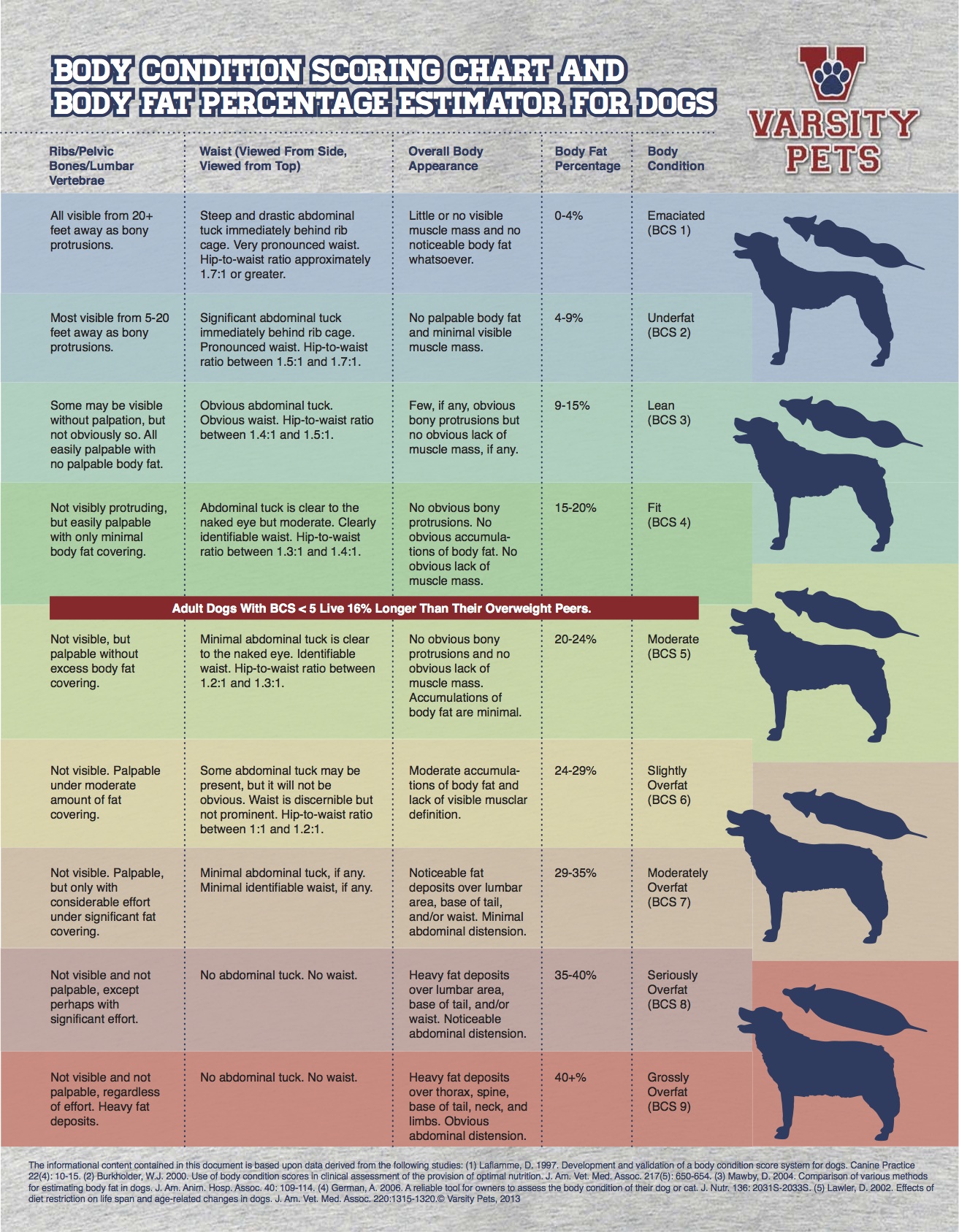
Never feed your dog these
There are certain ‘foods‘ your dog should never be fed. Some of these can be fatal or cause severe illness, even in small amounts.
They are either toxic or dangerous to the dog’s internal organs.
Symptoms range from causing vomiting, trouble breathing, seizures, kidney failure, liver failure, tremors, paralysis, abnormal heart rhythms, damage to the nerve system, internal lacerations, bowel obstruction and perforation, cardiac arrest, and death.
For example, grapes are highly toxic to dogs and known to cause kidney failure, in some dogs, as little as one or two grapes.
If your dog ingests any of these, consult your vet straight away.
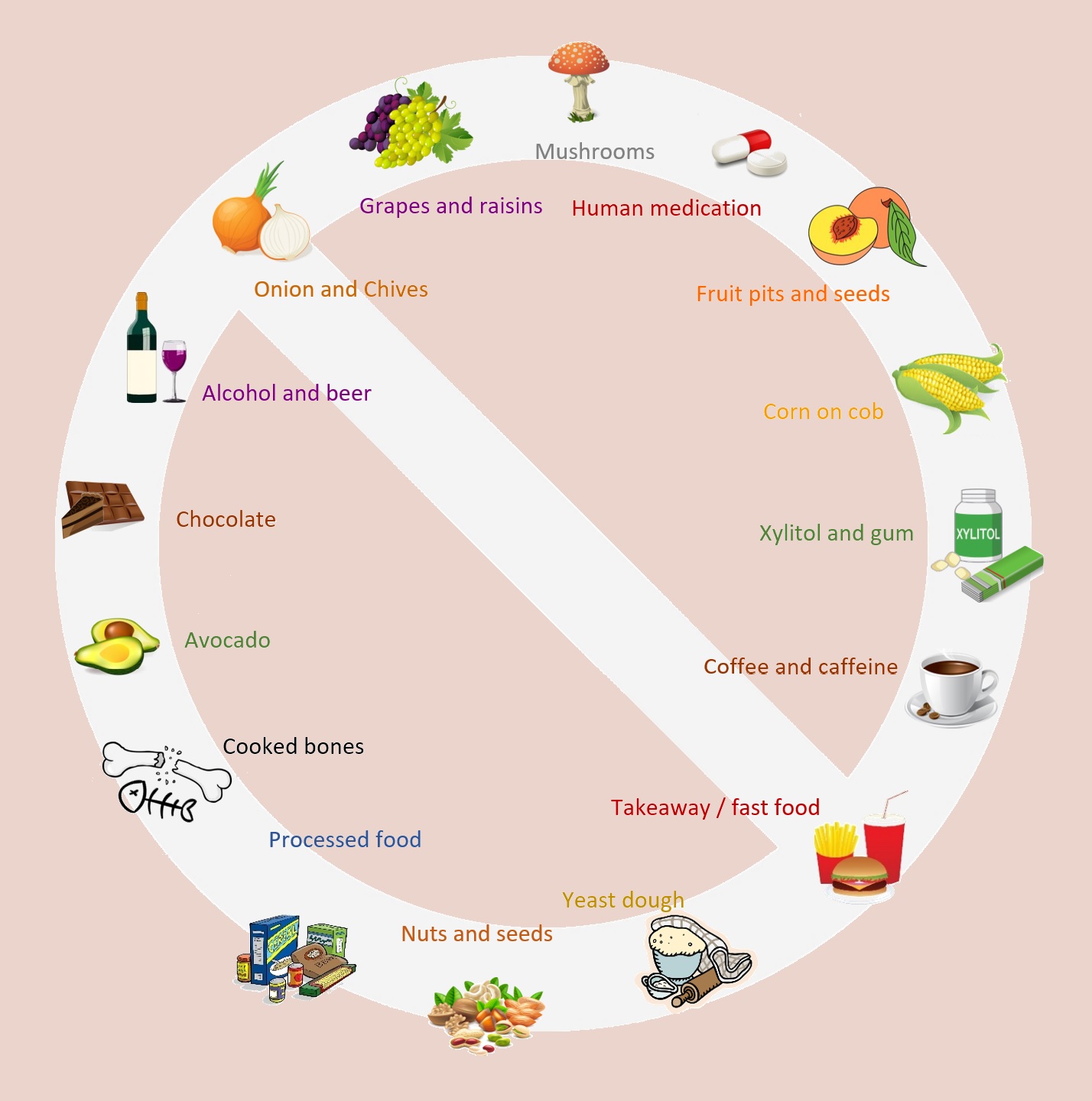 Further information about diet, suggested recipes, feeding amounts, and special diets are contained in our Puppy Handbook which you will receive when you take your Kodalihart puppy home. We are always available to answer your questions about diet in relation to your puppy.
Further information about diet, suggested recipes, feeding amounts, and special diets are contained in our Puppy Handbook which you will receive when you take your Kodalihart puppy home. We are always available to answer your questions about diet in relation to your puppy.

